
| by Delfina de Araujo (cont.) |

| by Delfina de Araujo (cont.) |
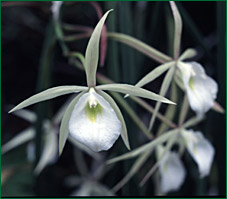 |
Brassavola
tuberculata Hook. The genus Brassavola R. Br. has at about seventeen species which grow since the sea level until 1.000m altitude and occurring in tropical America (from Mexico until South America). Brazil has at about eight species distributed from the north to the south of the country. The leaves are cylindrical, called subterete, and are like Welsh onion. They are epiphyte, the flowers are long lasting, scented, white and white-greenish. This species has been approached in Orchid News # 15. |
| Cyrtopodium
sp. The genus Cyrtopodium R. Br. has at about 40 species which occur from Florida until Argentina and Brazil has at about 35. The center of the distribution is the Central Plateau, in "cerrado" (Savannah) area. The species (one or more) occurring in Rio de Janeiro city, besides Cyrtopodium polyphylum (Vell.) Pabst ex F. Barros hasn't been definitively identified until today. It was formerly classified as Cyrtopodium andersonni but, nowadays, it is believed that it doesn't occur in the south or southeast of the country. It comes from Central America and, in Brazil, just occurs in the states of the north: Amapá, Amazonas and Roraima and perhaps in Central Plateau. Guido Pabst, himself, has regretted, in a letter sent to a friend, having perpetuating this mistake in his book. Nowadays, those plants are, in fact, considered as Cyrtopodium cardiochilum Lindl. or Cyrtopodium glutiniferum Raddi however many researchers believe that they are synonyms and didn't arrive to a definitive conclusion about the subject. In general, it is supposed that there are, at least, two more species besides Cyrtopodium polyphylum (Vell.) Pabst ex F. Barros. |
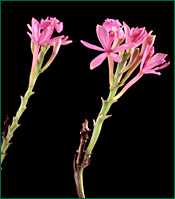 |
Epidendrum denticulatum Barb. Rodr. The genus Epidendrum has more than 1.000 species distributed since Florida until Argentina. Those plants are epiphyte, terrestrial or rupicolous. Brazil has more than 10% of those species. This species, Epidendrum denticulatum, was approached in Orchid News # 22 and Orchid News # 13. |
 |
Habenaria
leptoceras Hook. Habenaria Willd. is the greatest genus of terrestrial orchids and has more than 500 species, distributed through Asia, Africa and South America. Brazil has more than 150 species. Habenaria leptoceras Hook is a plant of humid and more or less shade places of the woods, it has green flowers in a densiflorum raceme. There are registers of very old collectings in Copacabana (by Riedel), Pedra dos Cabritos - Tijuca (by Hoehne), Governador Island (by Neves), Pedra da Gávea (by Armando Frazão). Pabst examined the material collected at Sumaré (l923) and Urca beach. It also occurs in the state of Espírito Santo and Minas Gerais. |
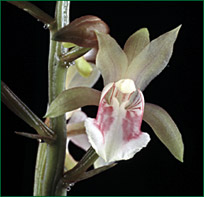 |
Oeceoclades
maculata (Lindl) Lindl. The genus Oeceoclades Lindl. has at about 31 species distributed through the South, Central and North America (Florida), tropical Africa, Madagascar, Mascarene and Seychelles islands. They are terrestrial and rarely occurs as epiphyte. This species, Oeceoclades maculata (Lindl) Lindl. is also known as Eulophidium maculatum (Lindl.) Pfitz. and is the only one species occurring in Brazil. It is a terrestrial plant occurring mainly in the humus layer. The leaves are variegates (mottled). The flowers are rose and small, measuring at about 1,5 cm diameter. |
|
The blooming
season is fall and often the flowers are short-living because they shrivel
as soon as they are pollinated and as it is self-pollinator, it occurs
very soon. The inflorescence can reach until 40 cm long and bears more
than 12 flowers. |
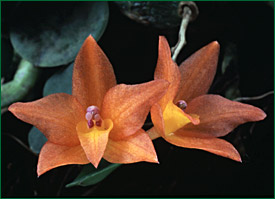 |
Sophronitis
cernua Lindl. |
|
Except for this
species and Sophronitis alagoensis, all of them need altitude above
500m and intermediate to cool conditions to be cultivated. |
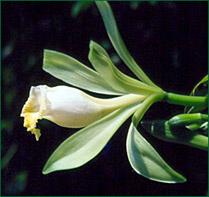 |
Vanilla
sp. The genus Vanilla Sw. has at about 50 species and is the only genus which has commercial value besides ornamental use. The capsules are used to obtain vanillin, a kind of flavoring to make ice cream or another sweetmeats. Brazil has at about 28 species. They are climbing plants and the flowers are short-live and sometimes, mainly during the summer and when exposed to full sun, they last less than 8 hours. Vanilla bahiana Hoehne occurs in the states of Alagoas, Bahia, Espírito Santo, Pará, Paraíba, Pernambuco, Rio Grande do Norte and Rio de Janeiro. See this GENUS in the site Brazilian Orchids |
|
About orchids from
Rio de Janeiro city, see:: |